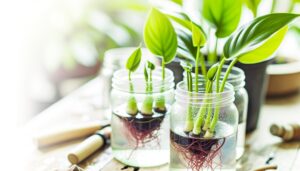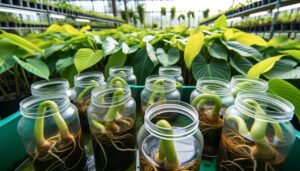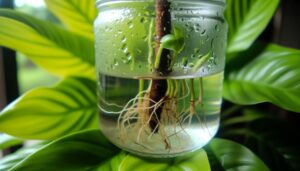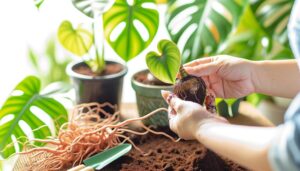Philodendron Bipennifolium Propagation
To propagate Philodendron bipennifolium effectively, commence by selecting healthy parent plants with vibrant foliage and robust root systems. Utilize sterilized pruning shears to take cuttings with two to three nodes.
Apply rooting hormone to the cut ends and place them in a well-draining rooting medium such as perlite or sphagnum moss. Maintain soil pH between 5.5 and 6.5, ensuring consistent moisture and 60-80% humidity.
Regularly inspect for root and shoot development, along with pests or diseases. Transplant successfully rooted cuttings into nutrient-rich, well-draining soil.
Following these guidelines will greatly enhance your propagation success. For further insights, continue exploring essential details.
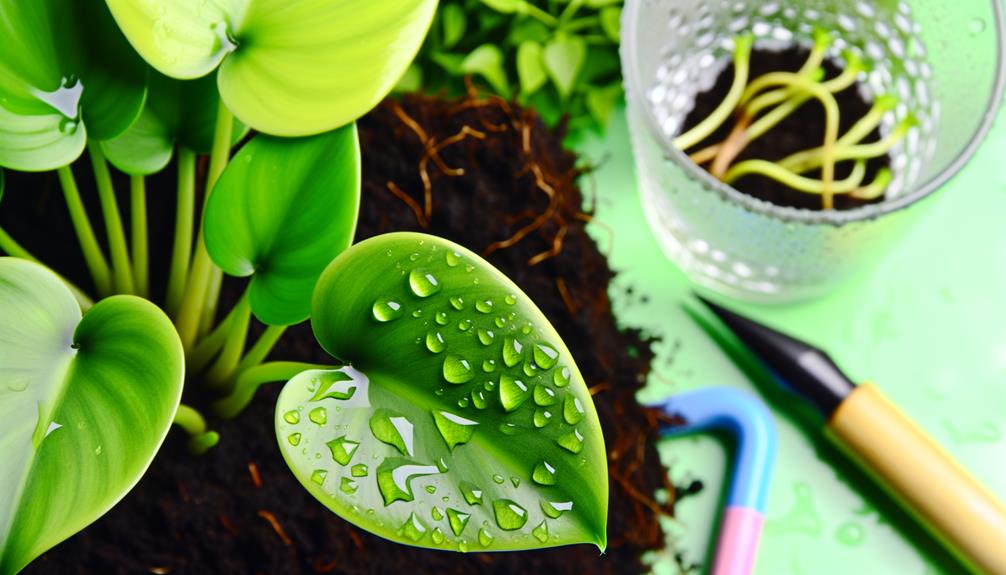
Key Takeaways
- Choose a healthy parent plant with vibrant foliage and well-developed roots to ensure successful propagation.
- Prepare cuttings with at least two to three nodes and allow for callus formation before planting.
- Use a well-draining rooting medium like perlite, sphagnum moss, or a peat and sand mixture.
- Maintain soil pH between 5.5 to 6.5 and water when the top inch of soil is dry.
- Ensure 60-80% humidity and good airflow to prevent fungal and bacterial infections during propagation.
Selecting Healthy Parent Plants
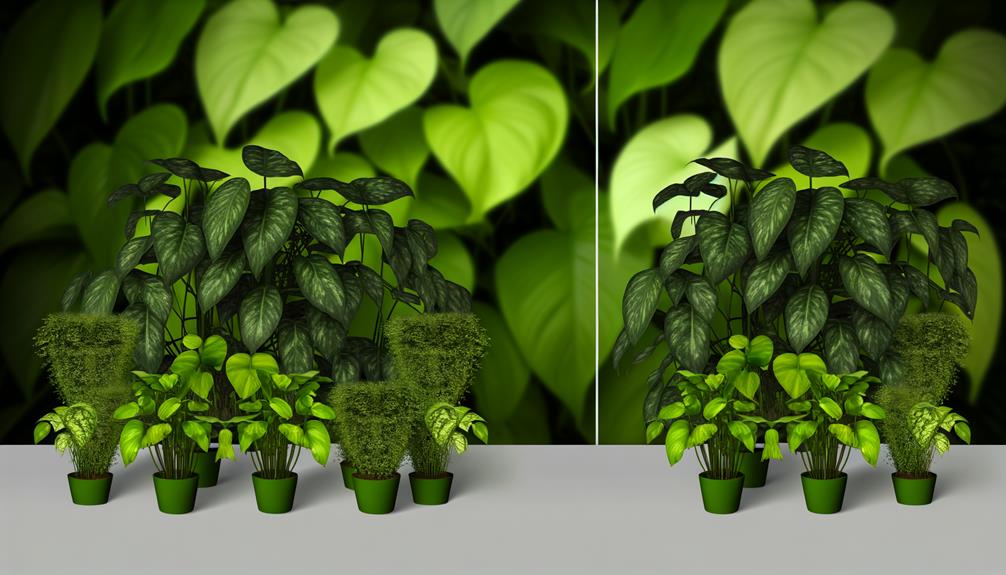
To guarantee successful spread of Philodendron bipennifolium, it is crucial to select parent plants that exhibit strong health, characterized by vibrant foliage, disease-free stems, and well-developed root systems.
Healthy foliage should be lush in color, typically a deep green, indicating efficient photosynthetic activity. Inspect stems thoroughly for any signs of disease, such as fungal infections or pest infestations, which can compromise the spread process.
The root system should be extensive and unblemished, as robust roots are essential for nutrient uptake and overall plant vigor. Ensuring these criteria will enhance the likelihood of successful cuttings and subsequent growth.
Selecting specimens that meet these strict health standards forms the foundation for optimal spread and plant development.
Gathering Necessary Supplies
To successfully propagate Philodendron Bipennifolium, it is imperative to assemble a thorough set of propagation tools, including sterilized pruning shears, rooting hormone, and clean water.
Additionally, selecting suitable soil mixtures and adequately sized containers will facilitate ideal root development and growth.
Ensuring these supplies are prepared will greatly enhance the likelihood of successful propagation.
Essential Propagation Tools
Successful propagation of Philodendron bipennifolium requires specific tools, including sterilized trimming scissors, rooting stimulant, a sanitized container, and a well-draining potting blend. Sterilized trimming scissors are important to minimize the risk of infection at the cutting site. Rooting stimulant speeds up root development, enhancing the success rate. A sanitized container is essential to prevent contamination, maintaining a healthy environment for root formation. The well-draining potting blend supports ideal aeration and moisture retention, crucial for root health.
| Tool | Purpose |
|---|---|
| Trimming Scissors | Clean cuts to reduce infection risk |
| Rooting Stimulant | Encourages rapid root growth |
| Sanitized Container | Prevents contamination |
| Well-Draining Blend | Maintains proper aeration and moisture |
| Spray Bottle | Sustains humidity without waterlogging |
Carefully selecting and preparing these tools is key for successful propagation.
Soil and Containers
Having the right soil and containers is crucial for ensuring the healthy establishment of Philodendron bipennifolium cuttings.
A well-draining, aerated soil mix is essential to prevent root rot and promote ideal growth. Ideally, a blend of peat moss, perlite, and orchid bark provides the necessary moisture retention and aeration. Sterilized soil reduces the risk of pathogen transmission.
Containers should have sufficient drainage holes to prevent water accumulation. Transparent plastic pots facilitate monitoring root development and moisture levels. Containers must be proportionate to cutting size, allowing ample space for root expansion without overwhelming the plant.
Using these precise supplies lays a robust foundation for successful propagation, ensuring vigorous growth and long-term plant health.
Choosing the Right Time
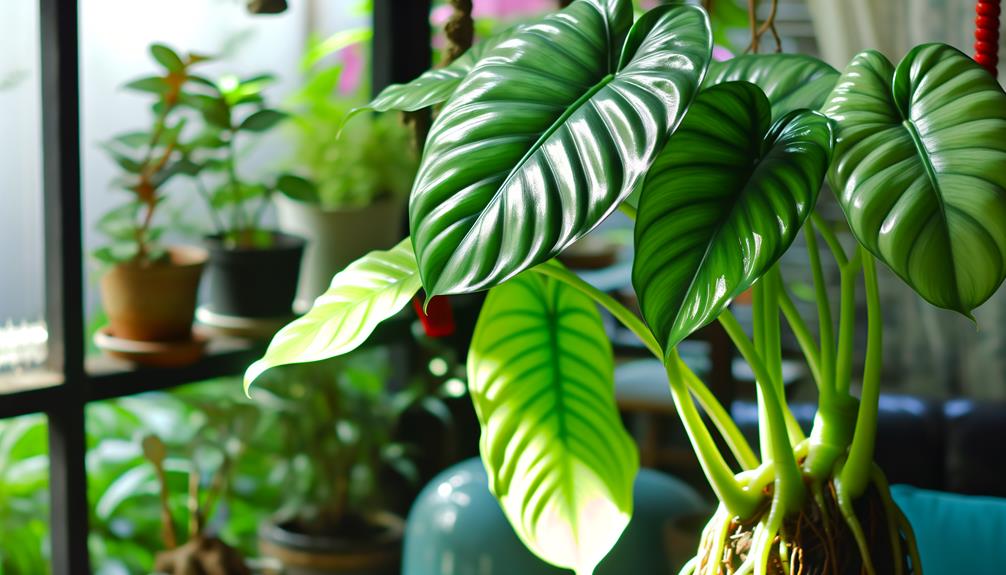
Determining the best season for propagating Philodendron bipennifolium is essential to ensure successful root development and plant growth. The best period for propagation is during the plant’s active growing season, usually spring to early summer.
During this period, the plant’s metabolic processes are at their peak, ensuring that cuttings can allocate resources effectively for root initiation and growth. Elevated ambient temperatures and increased daylight hours contribute to enhanced photosynthetic activity, which in turn supports robust root and shoot development.
Conversely, attempting propagation during fall or winter, when the plant enters a dormant phase, often results in lower success rates due to reduced metabolic activity and limited energy reserves. Thus, timing the propagation correctly is essential for achieving optimal results.
Preparing the Cutting
To prepare the cutting, choose a healthy stem that has at least two to three nodes and a few mature leaves. Utilize sterilized pruning shears to make a clean, diagonal cut just below a node, which is essential for maximizing the surface area for root development.
Make sure that the selected stem is free from any signs of disease or pest infestation, as these factors can negatively impact the propagation success. Remove any lower leaves near the cutting site to reduce potential rot and allocate more energy towards root formation.
Allow the cutting to air dry for an hour to form a protective callus over the cut surface, thereby minimizing the risk of pathogen entry during the rooting phase.
Rooting Medium Options
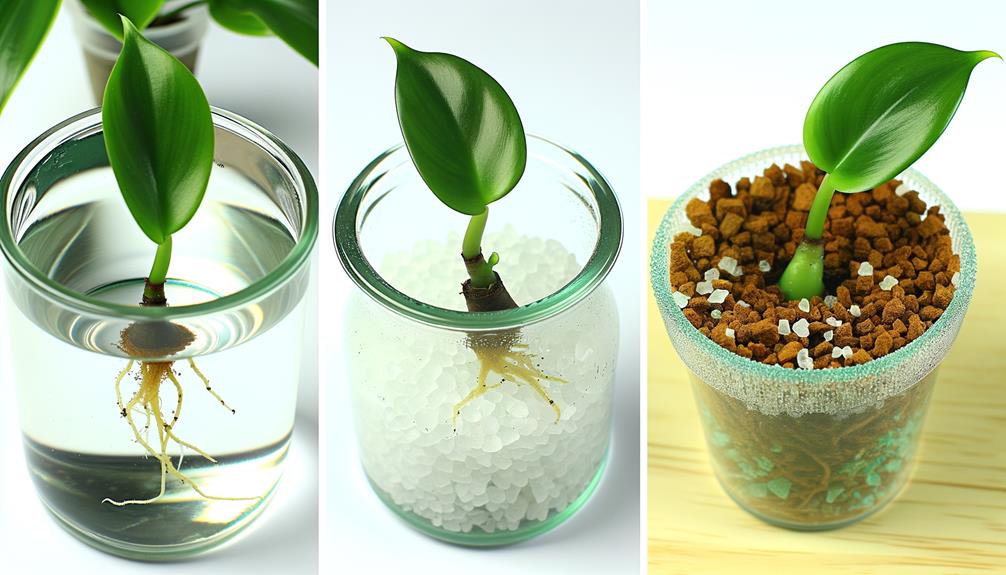
Selecting an appropriate rooting medium is crucial for the successful propagation of Philodendron bipennifolium, as it provides the necessary environment for root initiation and growth. Commonly used mediums include perlite, sphagnum moss, and a blend of peat and sand.
Perlite, a volcanic glass, guarantees excellent aeration and drainage, preventing root rot. Sphagnum moss retains moisture while providing a stable environment for delicate roots. A peat and sand mixture offers a balance of moisture retention and drainage, reducing the risk of fungal infections.
Each medium has distinct advantages, and the choice depends on specific environmental conditions and personal preferences. Maintaining sterility of the medium is paramount to prevent pathogen proliferation, thereby promoting healthy root development.
Placing the Cutting
Once the rooting medium is prepared, it is crucial to place the Philodendron bipennifolium cutting in a manner that maximizes root development and minimizes stress to the plant.
Follow these steps:
- Select a Healthy Node: Confirm the cutting has at least one healthy node, as this is where root initiation will occur.
- Insert at Correct Depth: Embed the cutting into the medium, burying the node approximately 2-3 centimeters deep.
- Proper Orientation: Position the cutting upright, making sure that the leaves are above the medium to facilitate photosynthesis.
- Stabilize Cutting: Securely fix the cutting in the medium to prevent movement, which can disrupt root formation.
Providing Optimal Conditions
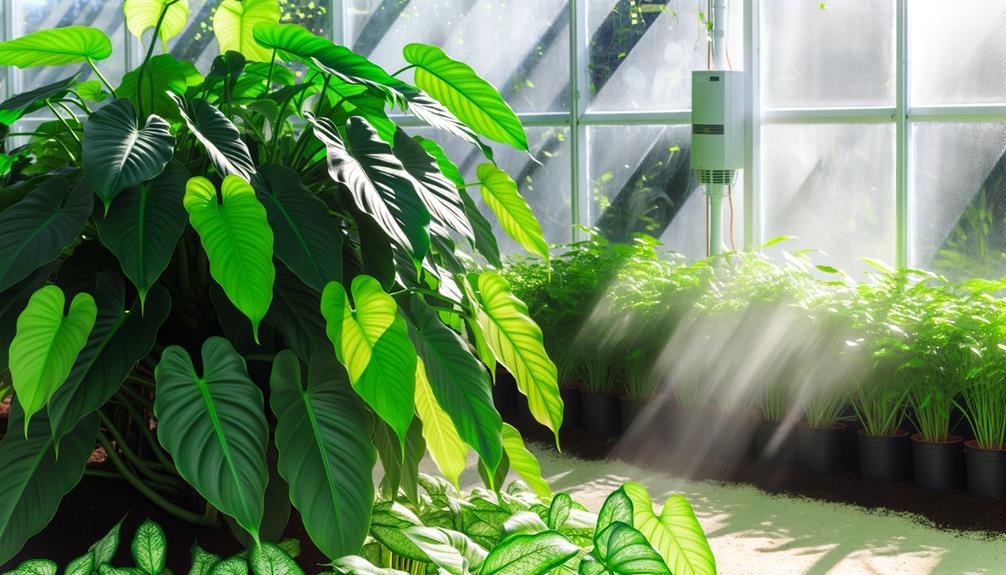
To guarantee successful propagation of Philodendron bipennifolium, it is essential to provide ideal conditions that encompass light and temperature, soil and watering, as well as humidity and airflow.
Adequate light and suitable temperature ranges facilitate photosynthesis and growth, while well-draining soil and consistent watering prevent root rot and other issues.
Additionally, maintaining ideal humidity and promoting proper airflow are crucial to fostering a healthy microenvironment for the developing plant.
Light and Temperature
Ensuring perfect light and temperature conditions is necessary for the successful propagation of Philodendron Bipennifolium, as these factors greatly influence growth and development.
Optimal conditions can be summarized as follows:
- Light Intensity: Bright, indirect light is essential. Direct sunlight can cause leaf burn, while insufficient light can hinder growth.
- Temperature Range: Maintain temperatures between 70-80°F (21-27°C). Temperatures below 60°F (15°C) can slow growth and potentially damage the plant.
- Humidity Levels: High humidity, around 60-70%, is perfect. Low humidity may result in stunted growth and leaf browning.
- Air Circulation: Adequate air movement helps prevent fungal diseases and supports healthy growth.
Adhering to these guidelines will promote robust and healthy propagation of Philodendron Bipennifolium.
Soil and Watering
Selecting the appropriate soil composition and establishing a precise watering regimen are critical components for the successful propagation of Philodendron Bipennifolium. The best soil should be well-draining yet moisture-retentive, ideally incorporating components such as peat moss, perlite, and orchid bark to prevent waterlogging while maintaining adequate aeration.
A balanced pH range of 5.5 to 6.5 is recommended to facilitate nutrient uptake. Watering should be performed when the top inch of soil becomes dry to the touch, ensuring that water permeates the root zone without causing oversaturation. Employing a regular but moderate watering schedule will prevent root rot and support healthy root development.
Monitoring soil moisture with a hygrometer can further refine the watering strategy for top-notch growth.
Humidity and Airflow
Maintaining ideal moisture levels and guaranteeing sufficient airflow are critical for the successful growth and propagation of Philodendron Bipennifolium. High moisture facilitates efficient gas exchange and prevents dehydration of tender new leaves. Conversely, adequate air circulation mitigates fungal and bacterial infections.
Optimum conditions can be achieved by adhering to the following guidelines:
- Moisture: Maintain relative moisture between 60-80% to simulate the plant’s natural tropical environment.
- Air Movement: Ensure consistent airflow using oscillating fans to prevent stagnant air pockets.
- Moisture Trays: Utilize water-filled trays with pebbles beneath pots to increase localized moisture.
- Spraying: Regularly spray leaves with distilled water to sustain moisture, avoiding waterlogging of the soil.
These practices collectively foster a conducive environment for healthy Philodendron Bipennifolium propagation.
Watering and Humidity
Proper watering and humidity levels are critical factors in the successful propagation of Philodendron bipennifolium, as they greatly influence root development and overall plant health.
Maintaining ideal soil moisture is paramount; the substrate should be kept consistently moist but not waterlogged to prevent root rot. A well-draining, aerated medium is recommended.
Humidity levels should be maintained between 60-80% to replicate the plant’s natural tropical environment, as high humidity promotes healthier foliage and robust root systems. Using a humidity tray or misting can help achieve these conditions.
Regular monitoring of both soil moisture and ambient humidity guarantees that the propagating cuttings receive sufficient hydration, facilitating vigorous growth and development.
Monitoring Growth

Continuous observation of root and shoot development is essential for evaluating the progress and health of Philodendron bipennifolium cuttings during propagation. This monitoring process involves several key steps:
- Root Inspection: Regularly check the roots for signs of growth, ensuring they develop a healthy white coloration and exhibit no signs of decay.
- Shoot Growth Measurement: Measure new shoot growth to assess the plant’s vigor, noting any changes in leaf size, shape, and hue.
- Pest Detection: Inspect cuttings for pests or disease symptoms, which can hinder growth.
- Environmental Conditions: Maintain ideal light, temperature, and humidity levels, adjusting as needed to support sustained development.
Careful monitoring enables early intervention, thereby enhancing the success rate of propagation efforts.
Transplanting New Plants
Transplanting newly propagated Philodendron bipennifolium necessitates meticulous attention to soil composition, ensuring a well-draining, nutrient-rich medium.
Adhering to ideal potting techniques, including appropriate container size and depth, is essential for root establishment.
Additionally, precise watering practices are essential to prevent root rot and promote healthy growth during the vital early stages.
Choosing Proper Soil
Selecting the appropriate soil composition is crucial for the successful transplantation and growth of Philodendron Bipennifolium. This species thrives in well-draining, aerated soil that mimics its natural tropical habitat.
A scientifically formulated soil mix should include:
- Organic Matter: Incorporate peat moss or coco coir to retain moisture while providing essential nutrients.
- Aeration Components: Add perlite or orchid bark to enhance soil aeration and prevent waterlogging.
- Nutrient-Rich Additives: Integrate compost or worm castings for a steady release of nutrients.
- pH Balance: Assure the soil is slightly acidic to neutral, ideally within a pH range of 5.5 to 6.5.
Potting Best Practices
Proper potting practices are essential to guarantee the healthy establishment and robust growth of newly propagated Philodendron Bipennifolium plants. Selecting an appropriately sized pot with adequate drainage is vital to prevent waterlogging, which can lead to root rot.
Utilize a potting mix rich in organic matter, ensuring it is well-aerated to promote root development. When transplanting, handle the roots gently to avoid damage, and position the plant at the same depth as it was previously growing. Firm the soil around the roots to eliminate air pockets, which can hinder root contact with the soil.
Post-transplant, the pot should be situated in a location with indirect light and stable temperatures to minimize transplant shock and facilitate acclimatization.
Watering Newly Transplanted
After securing the newly transplanted Philodendron Bipennifolium in its pot, it is crucial to implement a detailed watering schedule to support root establishment and minimize transplant shock. An effective watering strategy includes:
- Initial Deep Watering: Fully saturate the soil immediately after transplantation to ensure moisture reaches the root zone.
- Consistent Moisture Levels: Maintain evenly moist soil without causing waterlogging, which can lead to root rot.
- Monitoring Soil Moisture: Utilize a moisture meter or finger test to check soil dampness, watering only when the top inch becomes dry.
- Environmental Conditions: Adjust watering frequency based on temperature and humidity; higher temperatures and lower humidity require more frequent watering.
This careful approach fosters ideal conditions for the Philodendron Bipennifolium’s recovery and growth.
Troubleshooting Common Issues
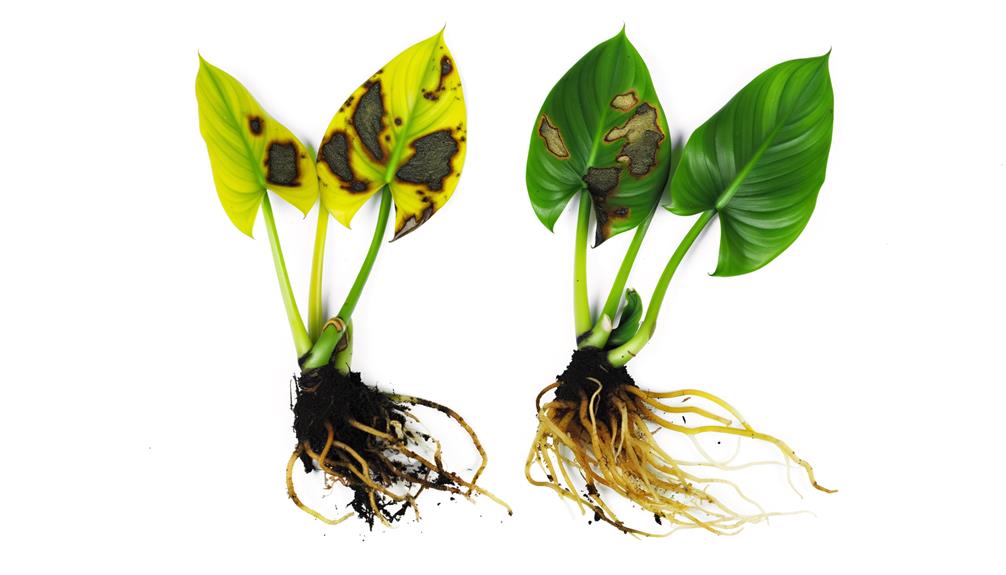
Identifying and addressing common issues in Philodendron bipennifolium propagation is crucial for promoting the healthy growth and development of new plants.
One prevalent issue is root rot, often caused by overwatering or poor drainage. To mitigate this, make sure the soil mixture is well-aerated and only water when the top inch of soil is dry.
Another frequent problem is inadequate light, which can result in leggy growth and reduced vigor. Position the plant in bright, indirect light to encourage robust development.
Pests, such as spider mites and aphids, can also hinder growth. Regularly inspect the foliage and apply appropriate insecticides or natural remedies if infestations are detected.
Addressing these issues promptly promotes successful propagation and thriving plants.
Conclusion
To sum up, the successful propagation of Philodendron bipennifolium depends on careful preparation and execution, much like a symphony requiring each instrument to play in harmony.
By choosing strong parent plants, using suitable rooting mediums, and maintaining ideal conditions for humidity and watering, one can promote healthy growth and eventual transplantation.
Monitoring and problem-solving guarantee the propagation process stays on course, leading to the cultivation of vibrant new specimens that contribute to botanical diversity.

